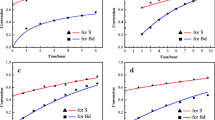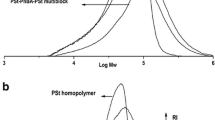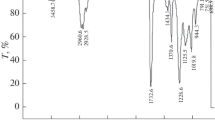Abstract
Thermoplastic elastomers (TPEs) are of growing commercial importance in the worldwide non-tire rubber market. It is because of their unique thermomechanical properties that associate with the phase morphologies. Controlled/living radical (mini)emulsion polymerization holds good promise for synthesis of ABA-type triblock copolymer TPEs. Both the mechanical and morphological investigations have been conducted on the solvent films of this copolymer latex. However, neither the copolymer latex particle nor the latex film has been investigated in terms of morphologies or mechanical properties. This work reports the development of triblock copolymer latex particle morphologies through reversible addition-fragmentation chain transfer (RAFT)-mediated miniemulsion polymerization. ABA-type triblock copolymers consisting of outer polystyrene blocks and inner polyacrylate blocks are synthesized in two steps through chain extension from symmetric RAFT agents. A variety of novel particle microstructures are realized by regulating either block ratios or particle surface attraction for each blocks. The nanostructured latex are also used for casting latex films. It is observed that the film morphologies do not attain thermodynamic equilibrium even after thermal annealing. In comparison to the solvent films with similar hard block contents, the latex films have higher elastic modulus, but exhibit inferior mechanical responses in terms of elongation at break and ultimate strength. The possible reason is attributed to the suppressed interparticle self-assembly of copolymers during latex film formation and scarce of bridging configuration of central block connecting different glassy domains within the final films.










Similar content being viewed by others
References
Tong JD, Jerome R (2000a) Synthesis of poly (methyl methacrylate)-b-poly (n-butyl acrylate)-b-poly (methyl methacrylate) triblocks and their potential as thermoplastic elastomers. Polymer 41:2499–2510
Spontak RJ, Patel NP (2000) Thermoplastic elastomers: fundamentals and applications. J Colloid Interface Sci 5:333–340
Tong JD, Jerome R (2000b) Dependence of the ultimate tensile strength of thermoplastic elastomers of the triblock type on the molecular weight between chain entanglements of the central block. Macromolecules 33:1479–1481
Zhang ZJ, Zhang LN, Li Y, Xu HD (2006) Styrene-butadiene-styrene/montmorillonite nanocomposites synthesized by anionic polymerization. J Appl Polym Sci 99:2273–2278
Kazmaier PM, Daimon K, Georges MK, et al (1997) Nitroxide-mediated “living” free radical polymerization: a rapid polymerization of (chloromethyl) styrene for the preparation of random, block, and segmental arborescent polymers. Macromolecules 30:2228–2231
Hawker CJ, Bosman AW, Harth E (2001) New polymer synthesis by nitroxide mediated living radical polymerizations. Chem Rev 101:3661–3688
Nicolas J, Guillaneuf Y, Lefay C, et al (2013) Nitroxide-mediated polymerization. Prog Polym Sci 38:63–235
Kamigaito M, Ando T, Sawamoto M (2001) Metal-catalyzed living radical polymerization. Chem Rev 101:3689–3746
Matyjaszewski K, Xia J (2001) Atom transfer radical polymerization. Chem Rev 101:2921–2990
Chiefari J, Chong YK, Ercole F, et al (1998) Living free-radical polymerization by reversible addition-fragmentation chain transfer: the RAFT process. Macromolecules 31:5559–5562
Moad G, Rizzardo E, Thang SH (2005) Living radical polymerization by the RAFT process. Aust J Chem 58:379–410
Jia Z, Liu J, Davis TP, et al (2009) RAFT polymerization and thiol-ene modification of 2-vinyloxyethyl methacrylate: towards functional branched polymers. Polymer 50:5928–5932
Zetterlund PB, Kagawa Y, Okubo M (2008) Controlled/living radical polymerization in dispersed systems. Chem Rev 108:3747–3794
Jennings J, He G, Howdle SM, et al (2016) Block copolymer synthesis by controlled/living radical polymerization in heterogeneous systems. Chem Soc Rev 45:5055–5084
Qiu J, Charleux B, Matyjaszewski K (2001) Controlled/living radical polymerization in aqueous media: homogeneous and heterogeneous systems. Prog Polym Sci 26:2083–2134
Lichti G, Gilbert RG, Napper DH (1983) The mechanisms of latex particle formation and growth in the emulsion polymerization of styrene using the surfactant sodium dodecyl sulfate. J Polym Sci: Polym Chem 21:269–291
Simms RW, Cunningham MF (2008) Compartmentalization of reverse atom transfer radical polymerization in miniemulsion. Macromolecules 41:5148–5155
Enriquez-Medrano FJ, Guerrero-Santos R, Hernandez-Valdez M, et al (2011) Synthesis of diblock and triblock copolymers from butyl acrylate and styrene by reverse iodine transfer polymerization. J Appl Polym Sci 119:2476–2484
Rieger J (2015) Guidelines for the synthesis of block copolymer particles of various morphologies by RAFT dispersion polymerization. Macromol Rapid Commun 36:1458–1471
Robin S, Guerret O, Couturier JL, et al (2002) Synthesis and characterization of poly (styrene-b-n-butyl acrylate-b-styrene) triblock copolymers using a dialkoxyamine as initiator. Macromolecules 35:3844–3848
Mayadunne RTA, Rizzardo E, Chiefari J, et al (2000) Living polymers by the use of trithiocarbonates as reversible addition-fragmentation chain transfer (RAFT) agents: ABA triblock copolymers by radical polymerization in two steps. Macromolecules 33:243–245
Delaittre G, Charleux B (2008) Kinetics of in-situ formation of poly (acrylic acid)-b-polystyrene amphiphilic block copolymers via nitroxide-mediated controlled free-radical emulsion polymerization. Macromolecules 41:2361–2367
Bowes A, McLeary JB, Sanderson RD (2007) AB and ABA type butyl acrylate and styrene block copolymers via RAFT-mediated miniemulsion polymerization. J. Polym Sci. Part A: Polym Chem 45:588–604
Guo TY, Tang D, Song M, et al (2007) Copolymerizations of butyl methacrylate and fluorinated methacrylates via RAFT miniemulsion polymerization. J Polym Sci, Part A: Polym Chem 45:5067–5075
Luo Y, Wang X, Zhu Y, et al (2010) Polystyrene-block-poly (n-butyl acrylate)-block-polystyrene triblock copolymer thermoplastic elastomer synthesized via RAFT emulsion polymerization. Macromolecules 43:7472–7481
Moineau C, Minet M, Teyssie P, et al (1999) Synthesis and characterization of poly (methyl methacrylate)-block-poly (n-butyl acrylate)-block-poly (methyl methacrylate) copolymers by two-step controlled radical polymerization (ATRP) catalyzed by NiBr2 (PPh3) 2. Macromolecules 32:8277–8282
Moineau G, Minet M, Teyssie P, et al (2000) Synthesis of fully acrylic thermoplastic elastomers by atom transfer radical polymerization (ATRP), 2. Effect of the catalyst on the molecular control and the rheological properties of the triblock copolymers. Macromol Chem Phys 201:1108–1114
Tong JD, Moineau G, Leclere P, et al (2000) Synthesis, morphology, and mechanical properties of poly (methyl methacrylate)-b-poly (n-butyl acrylate)-b-poly (methyl methacrylate) triblocks. Ligated anionic polymerization vs atom transfer radical polymerization. Macromolecules 33:470–479
Nicolas J, Charleux B, Guerret O, et al (2005) Nitroxide-mediated controlled free-radical emulsion polymerization using a difunctional water-soluble alkoxyamine initiator. Toward the control of particle size, particle size distribution, and the synthesis of triblock copolymers. Macromolecules 38:9963–9973
Wei R, Luo Y, Zeng W, et al (2012) Styrene-butadiene-styrene triblock copolymer latex via reversible addition-fragmentation chain transfer miniemulsion polymerization. Indus Eng Chem Res 51:15530–15535
Zhan X, He R, Zhang Q, et al (2014) Microstructure and mechanical properties of amphiphilic tetrablock copolymer elastomers via RAFT miniemulsion polymerization: influence of poly [styrene-alt-(maleic anhydride)] segments. RSC Adv 4:51201–51207
Nicolas J, Ruzette AV, Charleux B, et al (2007) Nanostructured latex particles synthesized by nitroxide-mediated controlled/living free-radical polymerization in emulsion. Polymer 48:7029–7040
Yang L, Sun P, Yang H, et al (2014) A feasible method of preparation of block copolymer latex films with stable microphase separation structures. Prog Org Coat 77:305–314
Winnik MA (1997) Latex film formation. J Colloid Interface Sci 2:192–199
Keddie JL (1997) Film formation of latex. Mater Sci Eng R 21:101–170
Vanderhoff JW, Bradford EB, Carrington WK (1973) The transport of water through latex films. J Appl Polym Sci 41:155–174
Lai JT, Filla D, Shea R (2002) Functional polymers from novel carboxyl-terminated trithiocarbonates as highly efficient RAFT agents. Macromolecules 35:6754–6756
Leibler L (1980) Theory of microphase separation in block copolymers. Macromolecules 13:1602–1617
Somani RH, Shaw MT (1981) Miscibility of acrylic polymers in polystyrene by melt titration. Macromolecules 14:1549–1554
Lansalot M, Davis TP, Heuts JPA (2002) RAFT miniemulsion polymerization: influence of the structure of the RAFT agent. Macromolecules 35:7582–7591
Kelley FN, Bueche F (1961) Viscosity and glass temperature relations for polymer-diluent systems. J Polym Sci 50:549–556
Yu B, Li B, Jin Q, et al (2007) Self-assembly of symmetric diblock copolymers confined in spherical nanopores. Macromolecules 40:9133–9142
Chen P, Liang H, Shi AC (2008) Microstructures of a cylinder-forming diblock copolymer under spherical confinement. Macromolecules 41:8938–8943
Rieger J, Zhang W, Stoffelbach F, et al (2010) Surfactant-free RAFT emulsion polymerization using poly (N, N-dimethylacrylamide) trithiocarbonate macromolecular chain transfer agents. Macromolecules 43:6302–6310
Muroi S (1966) Some physicochemical properties of poly (ethyl acrylate) emulsions containing carboxyl groups. J Appl Polym Sci 10:713–729
Semenov AN (1993) Theory of block copolymer interfaces in the strong segregation limit. Macromolecules 26:6617–6621
Richard AL (1994) Interface and surface effects on the glass-transition temperature in thin polymer films. Faraday Discuss 98:219–230
Sperry PR, Snyder BS, O'Dowd ML, et al (1994) Role of water in particle deformation and compaction in latex film formation. Langmuir 10:2619–2628
Honeker C C, (1996) Thomas E L. Impact of morphological orientation in determining mechanical properties in triblock copolymer systems. Chem Mater 8: 1702–1714.
Roos A, Creton C (2005) Effect of the presence of diblock copolymer on the nonlinear elastic and viscoelastic properties of elastomeric triblock copolymers. Macromolecules 38:7807–7818
Acknowledgements
This project is financially supported by Zhejiang Provincial Natural Science Foundation of China (LY15E030013 and LY12E03008), the Science and Technology Department of Zhejiang Province (2016C31074, 2017C31033), Zhejiang Xinmiao, Talent Project (2015R406030) and National Natural Science Funds of China (Grant No. 21636008).
Author information
Authors and Affiliations
Corresponding author
Ethics declarations
Conflict of interest
The authors declare that they have no conflict of interest.
Electronic supplementary material
ESM 1
(PDF 340 kb)
Rights and permissions
About this article
Cite this article
Yang, L., Han, Q., Song, Q. et al. Control over ABA-type triblock copolymer latex morphology in RAFT miniemulsion polymerization and mechanical properties of the latex films. Colloid Polym Sci 295, 891–902 (2017). https://doi.org/10.1007/s00396-017-4072-2
Received:
Revised:
Accepted:
Published:
Issue Date:
DOI: https://doi.org/10.1007/s00396-017-4072-2




